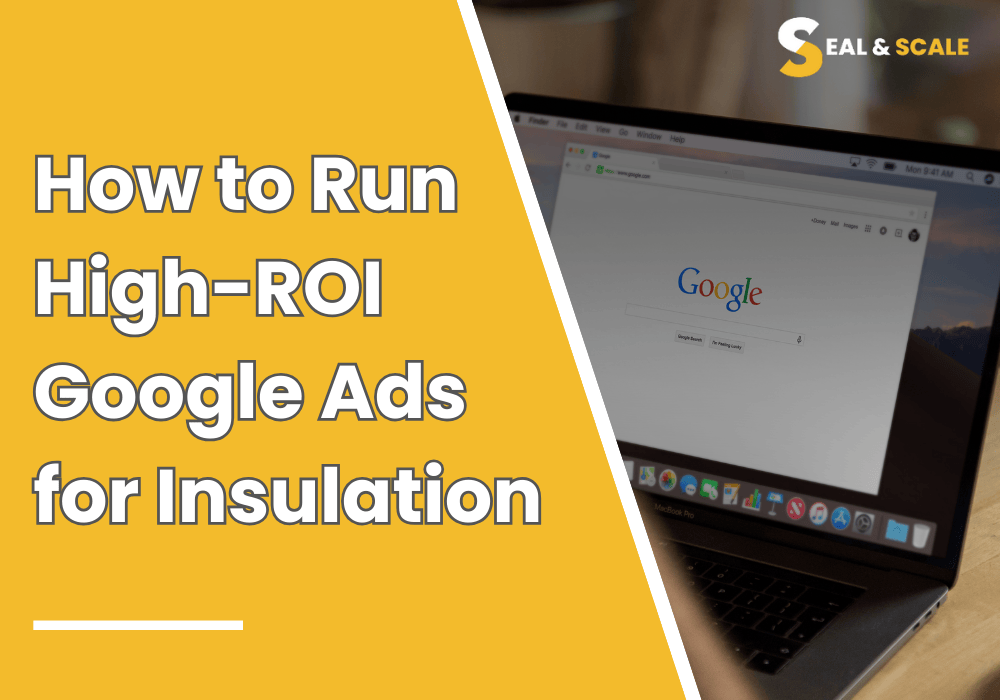How to Run High-ROI Google Ads for Insulation Contractors
- September 4, 2025

How Insulation Contractors Can Run High-ROI Google Ads in the US
Google Ads Can Be a Profit Engine for Insulation Companies
Homeowners in the United States often search for “attic insulation near me” or “spray foam insulation contractor” when they’re ready to hire. That makes Google Ads one of the fastest ways to put your insulation business in front of people who are already looking for your services. Unlike social media ads that interrupt, search ads match intent—someone types in a need, and your ad can show up instantly.
For insulation contractors, this means you can book jobs faster, fill slow weeks, and keep crews working year-round. But to get real return on investment (ROI), you need more than just setting up a campaign. You need a clear plan that cuts wasted spend and brings in the right calls.
What ROI Really Means for Insulation Contractors
Before diving into campaign setup, it helps to look at ROI in contractor terms. Here’s a simple breakdown:
- Cost per click (CPC): The price you pay each time someone clicks your ad. For insulation, it may range from $8 to $25 depending on the service and location.
- Lead conversion rate: How many clicks turn into calls or form fills.
- Close rate: How many leads become paying customers.
- Customer value: Average revenue from one insulation job (often $2,000–$5,000+).
Example: If you pay $15 per click, and 1 in 10 clicks becomes a lead, your cost per lead (CPL) is $150. If half of those leads turn into booked jobs worth $3,000, your cost per job is $300, which is a 10x return.
That’s the math that makes Google Ads worth running—if campaigns are set up and tracked correctly.
Build Campaigns Around Services and Cities
One of the best ways to keep insulation PPC campaigns clean and efficient is to match your account structure to your actual services and service areas.
- Separate campaigns by service type. Create one for attic insulation, one for spray foam insulation, one for crawl space insulation, and one for commercial insulation. This way you can adjust budgets and messaging based on which service drives more profit.
- Use ad groups for search intent. Within each campaign, group keywords like “near me,” “cost,” and “contractor” together. This helps write more specific ads that match what the searcher typed.
- Target cities or ZIP codes individually. Insulation demand can vary even across neighborhoods. Running city-specific ad groups (“insulation contractor Dallas TX” or “spray foam Houston 77002”) makes your ads feel local and relevant.
This setup may take more time upfront, but it pays off with stronger click-through rates and lower CPL.
Match Types That Keep Budgets Under Control
When picking keywords, match types matter. For insulation ads:
- Start with phrase match and exact match. These ensure your ad shows only when searches closely match your service.
- Be careful with broad match. It can drive extra clicks but also pull in irrelevant traffic unless you have strong negative keywords and conversion data to guide smart bidding.
This balance helps control spend while still capturing valuable search volume.
Negative Keywords Every Insulation Contractor Should Use
Nothing drains budget faster than bad clicks. Adding negative keywords is one of the easiest ways to stop wasting money. A starter list for insulation contractors includes:
- DIY, do it yourself, tutorial, how to
- Jobs, career, salary, training, course
- Wholesale, supplies, kit, rental, spray foam kit
- Free, cheap, lowes, home depot
- Soundproof, automotive (unless you do these services)
Check your search term reports weekly and keep adding words that don’t match the jobs you want.
Local Targeting That Brings the Right Calls
Google Ads allows you to show your ads only where you work. For insulation companies in the US, this means:
- Set location targeting to “Presence: People in or regularly in your location.” This avoids clicks from people outside your service area.
- Target by ZIP code or radius. For example, if your crew won’t drive more than 40 miles, set a radius around your office or customer hotspots.
- Adjust bids by location. If jobs in one ZIP are more profitable, you can increase bids for that area while lowering them elsewhere.
Show Ads Only When You Can Answer
If you run ads 24/7 but no one answers the phone at night, you’re paying for missed calls. Ad scheduling fixes this:
- Run ads during business hours when your staff can pick up.
- Use call extensions or call-only ads during peak hours.
Test evening or weekend hours if you know your target homeowners often search then.
Writing Ads That Get Clicks and Calls
The right ad copy makes all the difference. Focus on clarity and homeowner benefits:
- Headlines: Use “Attic Insulation in [City]” or “Spray Foam Contractor – Free Estimate.”
- Benefits: Highlight rebates, energy savings, or same-day service.
- Extensions: Add call extensions, sitelinks (attic, crawl, spray foam), and callouts (licensed, insured, financing available).
The goal is to show why your company is the easy choice and make it simple to call.
Offers That Get Homeowners to Act
Insulation is not always urgent—many homeowners put it off. Strong offers can push them to contact you sooner. Try:
- Free attic inspection
- Help with utility rebates
- $0 down financing options
- Same-day quotes
These simple value-adds can lift conversion rates without cutting your core pricing.
Landing Pages Built for Leads
Your ads are only as strong as the page they send traffic to. Sending all clicks to your homepage often wastes good leads. Instead:
- Create one page per service + city (e.g., “Attic Insulation in Austin”).
- Place your phone number and form above the fold.
- Use before-and-after photos and explain R-values in plain terms.
- Add trust signals like reviews, licenses, and rebate info.
Also, make sure your landing pages load fast and look good on mobile. More than half of searches for insulation services happen on phones.
Smart Bidding and Budget Tips
When you’re starting out, manual CPC or Max Clicks with a bid cap gives you control. Once you collect at least 30 conversions in 30 days, you can test Google’s smart bidding options like Maximize Conversions or Target CPA. These can help scale results but only work well with enough data.
Budget-wise:
- Start with $50–$100 per day per campaign if possible.
- Track CPL by service type. If spray foam leads cost $200 and attic insulation leads cost $100, shift more budget to attic until ROI evens out.
- Always set daily budgets high enough to get clicks but not so high that wasted spend grows.
Tracking Conversions the Right Way
One of the biggest mistakes contractors make is not tracking what happens after a click. At a minimum, you should track:
- Calls directly from ads
- Calls from your website
- Form fills
- Chat or text leads
For even better data, import offline conversions. For example, mark which calls turned into booked jobs and feed that back into Google Ads. This helps Google learn what a good lead looks like and improves bidding.
Call Tracking That Works
Dynamic number insertion (DNI) tools let you see which keywords and ads drove each phone call. You can also tag calls by type (residential vs. commercial, attic vs. crawl). Over time, this tells you where your best jobs come from.
Keep Improving With a 30/60/90-Day Plan
Google Ads isn’t set-and-forget. Here’s a simple cadence:
- First 2 weeks: Add negative keywords, check search term reports, make sure leads are being tracked.
- Day 30: Review ad performance, pause low-performing ads, shift budget to best ZIPs.
- Day 60–90: Test new ad copy, add remarketing, try broad match with smart bidding if data supports it.
This steady adjustment process keeps CPL dropping and ROI climbing.
Local Services Ads vs. Google Ads
Many insulation contractors in the US now run Local Services Ads (LSAs) as well. These show above search ads with the “Google Guaranteed” badge. LSAs can drive quality leads, but they work differently from PPC. A smart approach is to run both, compare cost per lead weekly, and adjust budgets. In most markets, the two channels complement each other.
Keyword Buckets to Start With
When building your keyword list, think like a homeowner. Here are some proven groups:
- Core intent: insulation contractor near me, insulation company in [city], home insulation.
- Service-specific: attic insulation, crawl space insulation, spray foam insulation, blown-in insulation.
- Commercial: warehouse insulation contractor, metal building insulation.
- Problem or benefit focused: drafty attic, lower energy bills, tax credit insulation, home energy audit.
Mix these with your service area names for the best local relevance.
Conclusion
Running high-ROI Google Ads for insulation contractors in the United States comes down to three things: a clear account structure, strong tracking, and ongoing adjustments. When you build campaigns around your real services, block bad clicks, and track which leads turn into jobs, you’ll stop guessing and start growing.
The payoff is worth it, steady calls, booked projects, and a marketing system you can count on even during slow seasons.
Digital Marketing Agency for Crawl Space Repair Contractors
© Copyright Seal and Scale 2025. All Rights Reserved

